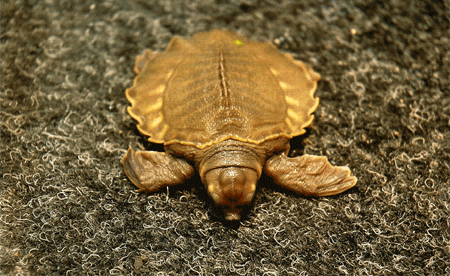Reproduction of the pig-nosed turtle Carettochelys insculpta
(RAMSAY, 1886) at the
Rotterdam Zoo. Radiata 14(3):3-12.
Gerard Visser & Henk Zwartepoorte
|
Housing and husbandry |
|
However, the fish population the turtles shared the aquarium with changed several
times. During the 1980s they shared the aquarium successively with three Australian lungfishes
Neoceratodus forsteri; during the 1990s followed by arowanas Osteoglossum bicirrhosum and
arapaimas Arapaima gigas, pacu's Colossoma macropomum and red-tailed catfish
Phractocephalus hemioliopterus. Since 2000 also four adult Arrau terrapins Podocnemis
expansa are housed in the same aquarium. Very recently the fish population was reduced to a large
group of twin-bar characins Tetragonopterus argenteus.
Due to temporarily changes in behaviour of individual specimens, the combination of the group of
Carettochelys changed several times. Sometimes, injured specimens were separately housed in off
exhibit tanks to recover.
The aquarium is filtered by an open biological filter, consisting of two 150 x 75 x 50 cm tanks filled with
a sand and gravel. Crude waste-material is filtered out by a cotton-wool filled section. One third of the
water contents is changed twice a week. The water temperature is 28 °C and this is maintained by the
central heating system, controlled via a thermostat, situated in one of the two filter compartments.
Diet
Pig-nosed turtles are opportunistic feeders, largely omnivorous, but they consume a higher ratio of
herbivore food, such as fruits (such as Pandanus-fruits), flowers and leaves, either direct from the
river bank vegetation, or after it has fallen into the water (ROEMPP2 003). According to GEORGES &
WOMBEY (1993) their herbivore diet includes Ficus racemosa, Syzygium forte and
Pandanus aquaticus. Aquatic plants such as algae, eelweed Vallisnera spp., and water
nymph Najas tenuifolia are also eaten when available. They also eat molluscs, crustaceans,
fishes and mammals (as carrion).
CANN(1978) observed his captive specimen to accept most food offered: crabs; freshwater crayfish, worms,
water hyacinth bulbs Eichhornia crassipes and fruit.
In Rotterdam Zoo it at first did not prove easy to get the animals to feed, probably due to the conditions
they had experienced during holding and transport while in transit from New Guinea to the dealer's shop in
Rotterdam. We learned from the keeping staff in Berlin Zoo that boiled potatoes could prove to be feeding
stimulus. This turned out to be successful and from then on further feeding problems in this species were
not experienced.
During the first decade in Rotterdam they were mainly fed on minced meat mixed with vitamin and
calcium/mineral supplements twice a week and vegetable matter as lettuce, endive, tomatoes, apples and
bananas three times a week. Since 1990 all fresh water turtles at Rotterdam Zoo are fed with a gel-food
developed in Germany by both Prof. Dr. WALTER SACHSSE and INGO PAULER. This gel-food is made in house in
the Zoo and consists of freshwater fish, commercially manufactured dog-food, ox heart, beef, spirulina
algae, shrimps, milk, water, vitamin and calcium/mineral supplements and high quality gelatine.
Reproduction biology
In northern Australia the nesting season is in the dry season, from mid-July to October or early November,
depending on the geographic location (DOODY et al. 2003a). The animals nest on sandy, loamy or muddy banks
and beaches, adjacent to the river (GEORGES & WOMBEY 1993). Females in Australia reproduce every second
year, but produce two clutches per year (DOODY et al. 2003a). Clutch size ranges from 7 to 19, but averages
around 10 eggs. The females show gregarious behaviour when nesting and during oviposition (up to 16 females
have been observed on one beach), but this does not seem to reduce the risk of predation (DOODY et al.
2003b). Nests are susceptible to predation by monitor lizards (Varanus spp.) and, in Northern
Australia, by being trampled upon by feral water buffalo (Bubalus bubalis).
TDS (Temperature Dependent Sex determination) is known in this species; the range of temperatures within
which both sexes are produced was found to be very narrow (around 1 °C) and was found centred around 32 "C.
This range separates the range of temperatures within which only females are produced (> 32.5 "C), from
the range within which males are produced (c 31.5 "C) (Young et al. 2004).
At 30 "C the embryos enter a diapause (aestivation) within the egg after 64-74 days (WEBB et al. 1986).
Yolk is then used at such a rate that the yolk supply can last up to about 60 more days. Data from natural
nests in New Guinea show that incubation periods in the wild range from 86-102 days at 31.6 'C. This would
confirm that this diapause occurs within this 59 day limit (GEORGES $amp; WOMBEY 1993). Hatching was
stimulated experimentally by reducing the availability of oxygen. This indicates that in the field the
stimulus is either the first rains of the season, or flooding (WEBB et al. 1986). The aestivation would
ensure that hatching would coincide with favourable conditions in the field.

